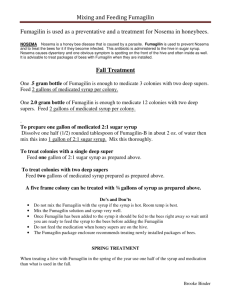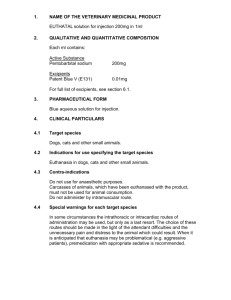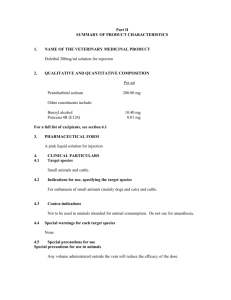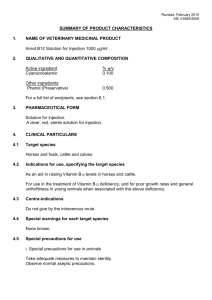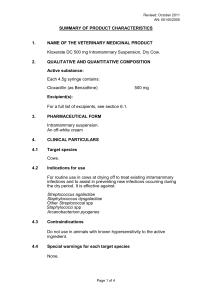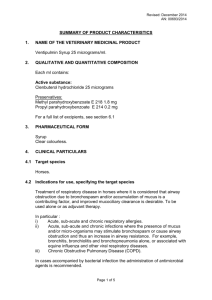fumidil b - Veterinary Medicines Directorate
advertisement
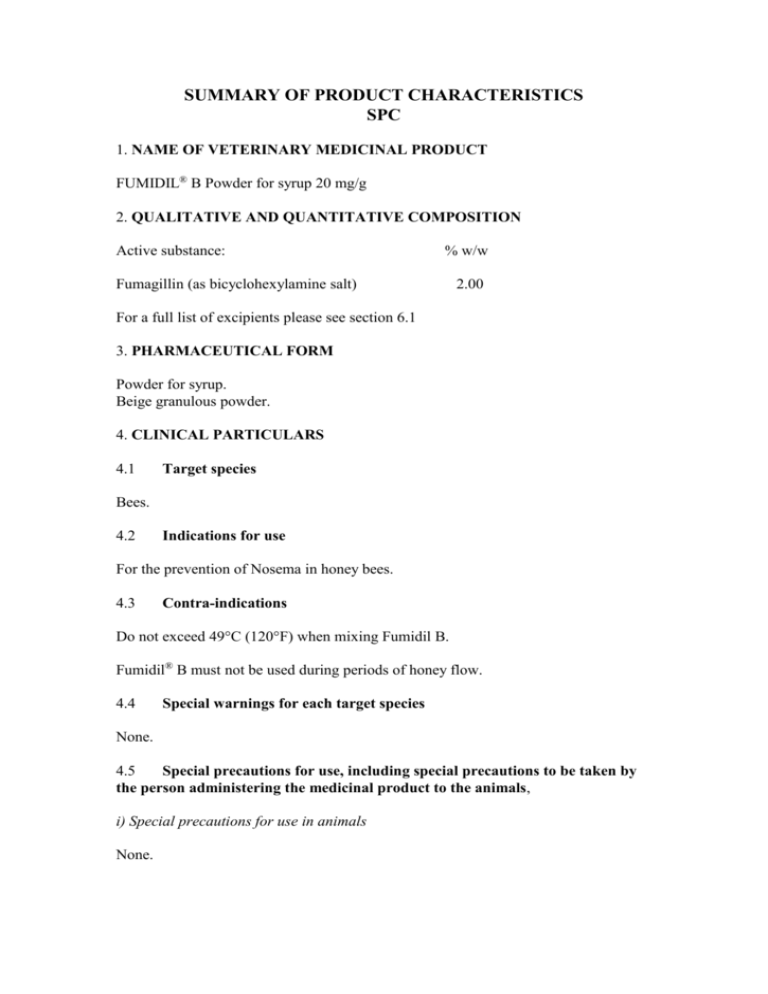
SUMMARY OF PRODUCT CHARACTERISTICS SPC 1. NAME OF VETERINARY MEDICINAL PRODUCT FUMIDIL® B Powder for syrup 20 mg/g 2. QUALITATIVE AND QUANTITATIVE COMPOSITION Active substance: % w/w Fumagillin (as bicyclohexylamine salt) 2.00 For a full list of excipients please see section 6.1 3. PHARMACEUTICAL FORM Powder for syrup. Beige granulous powder. 4. CLINICAL PARTICULARS 4.1 Target species Bees. 4.2 Indications for use For the prevention of Nosema in honey bees. 4.3 Contra-indications Do not exceed 49°C (120°F) when mixing Fumidil B. Fumidil® B must not be used during periods of honey flow. 4.4 Special warnings for each target species None. 4.5 Special precautions for use, including special precautions to be taken by the person administering the medicinal product to the animals, i) Special precautions for use in animals None. ii) Special precautions to be taken by the person administering the medicinal product to animals: Avoid inhaling powder when mixing. Wear a filtering half mask respirator EN149 type FHM2 and a single use disposable gloves when preparing the treatment. Wash hands and exposed skin before eating, drinking or smoking. 4.6 Adverse reactions (frequency and seriousness) None known. 4.7 Use during pregnancy, lactation or lay Not applicable. 4.8 Interaction with other medicinal products and other forms of interaction None reported. 4.9 Amounts to be administered and administration route Each colony to be treated should receive approximately 166 mg of fumagillin activity. There are 2 pack sizes: 25 g and 475 g. 25 g pack 166 mg of fumagillin activity is equivalent to one-third of a 25 g vial. The amount to be given to a colony is administered in a syrup containing 6.35 kg (14 lb) of sugar in 4 litres (7 pints) of water. Precise measurement is not essential since a “rough third” of the 25 g vial is more than adequate for the treatment of the average colony. It is easier to dissolve the sugar in warm water. It is, however, important that Fumidil® B is NOT subjected to a temperature higher than 49°C (120°F) during any stage of the mixing operation. 1. Heat 7 pints of water per colony to 38-49°C (100-120°F) 2. Apportion one third of the 25 g vial for each colony to be treated and dissolve in the heated water 3. While the water is still hot, add 6.35 kg (14 lbs) of sugar per colony and stir to make a clear syrup 4. Feed this syrup to the bees in the usual way 475 g pack This large pack contains 9.5 g fumagillin activity which makes sufficient syrup to treat 54 colonies. The contents of this pack should be dissolved in 216 litres (47½ gallons) of water to which 343 kg (6¾ cwt) of sugar should be added as described above. 1. Heat 216 litres (47½ gallons) of water to 38-49°C (100-120°F) 2. Dissolve the whole contents of the pack in the heated water 3. While the water is still hot, add 343 kg (6¾ cwt) of sugar and stir to make a clear syrup 4. Feed this syrup to the bees in the usual way 5. Once this pack is opened, the contents must be used within 2 weeks Fumidil® B is effective when fed in syrup in the autumn (September and October). It can also be used in spring when the first few warm days occur. Fumidil® B has no effect on the spores or the resting stage of Nosema apis and must therefore be made available in the food of bees for three or four weeks to free the colony population of infection. To prevent reinfection from spores carried by the combs, the latter should be replaced by clean combs early in spring. 4.10 Overdose (Symptoms, emergency procedures, antidotes) Not applicable. 4.11 Withdrawal periods for the various foodstuffs, including those for which the withdrawal period is zero Honey – Zero hours 5. PHARMACOLOGICAL PROPERTIES Bicyclohexylamine fumagillin is the soluble salt of an antimicrobial produced by Aspergillus fumigatus. This antimicrobial exhibits a specific action against the protozoon organism, Nosema apis, the cause of nosema disease in honey bees. The antimicrobial prevents the reproductive stages of the parasites attacking the epithelial cells of the digestive stomach of the bee. Fumidil B has no effect on the spores or resting stage of Nosema apis and must therefore be made available in the food of bees for three to four weeks to free the colony population of infection. 6. PHARMACEUTICAL PARTICULARS 6.1 List of excipients Polysorbate 80 Sodium phosphate (anhydrous) Sodium acid phosphate (anhydrous) 6.2 Major incompatibilities None Reported 6.3 Shelf-life Shelf life of veterinary medicinal product as packaged for sale: 2 years Shelf life after first opening the immediate packaging: 2 weeks Shelf life after dilution or reconstitution according to directions: 24 hours 6.4 Special precautions for storage Do not Store above 25°C (77°F). Any medicated syrup which is not used within 24 hours should be discarded. Once the pack is opened the contents should be used within 2 weeks. Store in a dry place. 6.5 Nature and contents of container (i) A natural low density polyethylene bottle closed by a natural low density polyethylene seal and cap (screw fit) containing 25 g of the product. (ii) A natural low density polyethylene bottle closed by a natural low density polyethylene seal and cap (screw fit) containing 475 g of the product. Not all pack sizes may be marketed. 6.6 Special precautions for the disposal of unused medicinal product or waste materials if any Any unused veterinary medicinal product or waste materials derived from such veterinary medicinal products should be disposed of in accordance with local requirements. 7. MARKETING AUTHORISATION HOLDER CEVA Animal Health Ltd 90 The Broadway Chesham Buckinghamshire HP5 1EG 8. MARKETING AUTHORISATION NUMBER Vm 15052/4013 9. DATE OF FIRST AUTHORISATION/RENEWAL OF THE AUTHORISATION First authorised: 01/01/1989 Renewed: 01/01/1994 10. DATE OF REVISION OF THE TEXT 09th October 2007 11. FURTHER INFORMATION None.
